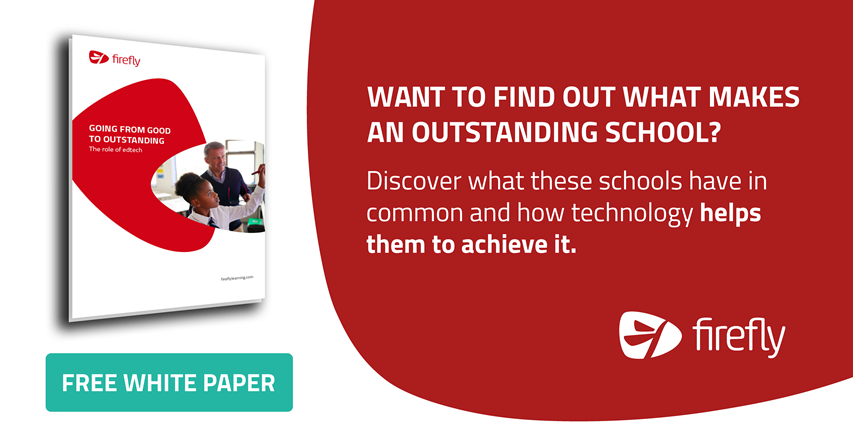Increasing blood pressure? Rising heart rate? Frantic panic? All these could be symptoms of an upcoming Ofsted inspection.
While not necessarily the case everywhere, more often than not a surprise inspection can be coupled with a frenetic, last-minute effort to cross all the T’s and dot all the I’s and make sure everything is ready for the surprise visitor. For some, the pressure has perhaps increased with the recent launch of Ofsted’s new inspection framework. The new framework now “focus[es] on the real substance of education: the curriculum”.
For us edtech-enthusiasts, this change is a much welcome one. Largely because we believe that the modern learning experience can support in delivering the quality Ofsted hopes to see and our students deserve to receive. In fact, there are many ways in which it can not only deliver quality but also reduce the aforementioned symptoms commonly associated with Ofsted visits. In this series of blogs, we’ll be exploring how technology can support each of the new Ofsted criteria, beginning with our personal favourite: Quality.
Criteria 1: Quality of education
We’ve taken a deep dive into each of its 3 sections: Intent, Implementation and Impact and provided some insight below.
Intent
Schools are expected to provide both breadth and depth of curricular options for students, allowing the development of a set of skills and knowledge necessary to become well-rounded productive citizens. Inspectors assess intent through interviews and exploring the provided curriculum and the documents school leaders typically use for planning.
The modern learning experience encourages a student-focused approach to learning, one that has not been possible before. Using such technologies, data is managed in a way that allows schools, even at the level of senior leadership, to focus in on students’ individual needs, and intervene with personalised solutions, whether at the student, classroom, teacher or school level. This birds-eye view also allows leaders to steer and manage the school while still keeping a clear view of implications on the ground.
Similarly, schools are now providing even more breadth of curricular material for students using online resources, such as MASSOLIT, Planet eStream, and the Global Online Academy. The latter is an organisation that allows students to engage in courses that are not usually provided in local schools, while engaging with students from all around the world, simultaneously being facilitated by a local teacher. This can provide students with rich experiences that are typically beyond most schools’ means.
Implementation
As part of the implementation criteria, inspectors look at how the intent plays out in the classroom. Inspectors explore how information is presented and engaged with, how student understanding is measured, and how teachers ensure that information is transferred to students’ long-term memory.
Edtech and the modern learning experience now allows us to explore a myriad of ways to allow students to engage with information. Whether it is through videos, games, or hands-on activities, edtech has allowed us to diversify the ways through which students interact with information. Whether it’s learning abstraction and problem solving through creating a line-following robot or learning about the table of elements through running virtual experiments on Minecraft, edtech can enrich the ways through which teachers deliver and students interact with content.
Feedback and assessment have also been transformed by edtech in recent years, showing that it can improve the quality of feedback students receive. Modern learning tools such as Firefly, can provide teachers and leaders with reports at various levels in an instant, not only making it an invaluable tool to personalise interventions but also allowing for hassle-free data gathering and generation.
Similarly, there are many tools that can support deepening students understanding and ensure knowledge is stored in long-term memory. Models such as the flipped classroom encourage deliberate practice with the teacher, as opposed to static-lecture based models. Tools such as Quizlet can facilitate spaced repetition, a learning technique that has shown to support long-term memory retention.
Impact
Measuring impact is complicated, as issues such as validity and bias play a big role in how impact is interpreted. For this reason, and others, inspectors will not be drawing on school-generated data to determine impact, but rather draw on other sources, such as the IDSR or direct observation. However, that does not mean that internally generated data does not play a role, as insights from internally generated data may be of interest to the inspector, particularly as they try to make sense of other sources, such as published national assessments.
Having a simultaneously holistic and detailed view of school data and student progress is necessary for an accurate understanding of the impact your school is having. Technologies such as Firefly can provide that level of granularity as well as breadth, making data-driven insights more reliable. Most notably one of the ways it does this is through its markbook.
We hope that these tools might relieve the amount of pressure felt by this new change in Ofsted requirements. Working with schools like yours, Firefly have built a platform specifically for the needs and requirements of today’s state schools. If you’d like to try some of the ideas proposed yourself, sign up for a free demo of Firefly Essentials.


